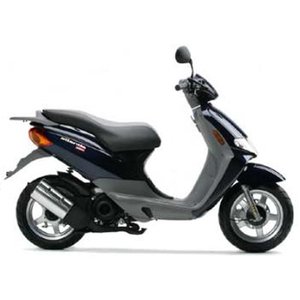Derbi Atlantis 50 AC [1999-2002]: A Retro Urban Companion That Stands the Test of Time
Introduction
The Derbi Atlantis 50 AC isn’t just a motorcycle—it’s a time capsule from an era when European streets buzzed with lightweight, stylish two-wheelers designed for urban adventurers. Produced between 1999 and 2002, this air-cooled 50cc machine carved its niche as a gateway to motorized freedom for teenagers and a practical runabout for city dwellers. With its quirky retro-futuristic design and approachable performance, the Atlantis 50 AC remains a charming relic of early-2000s mobility culture. But how does it hold up decades later? Let’s throttle into the details.
Design: Retro Charm Meets Functional Simplicity
The Atlantis 50 AC’s design is a delightful contradiction. Its angular bodywork, chunky front fairing, and trapezoidal headlight scream late-’90s futurism, while the stepped seat and rounded tail section nod to classic moped styling. The color schemes—often bold metallics like electric blue or fiery red—radiate youthful energy, making it stand out in a sea of bland commuter scooters.
The step-through frame isn’t just a stylistic choice; it’s a practical one. At 730 mm (28.7 inches) tall, the seat accommodates riders as young as 16 while still being comfortable for adults up to 180 cm (5’11”). The analog speedometer and basic indicator lights keep things simple, though the lack of a fuel gauge (common for its class) means you’ll need to rely on the 7.2-liter (1.9-gallon) tank’s odometer tracking. Storage is minimal—a small under-seat compartment fits a rain jacket or a baguette, but not both.
Engine and Performance: Modest Power, Maximum Fun
Let’s be clear: the Atlantis 50 AC won’t win drag races. Its air-cooled single-cylinder engine produces 3.4 kW (4.6 PS), translating to a governed top speed of 45 km/h (28 mph) to comply with European moped laws. But in crowded city centers, this limitation becomes a strength. The engine’s raspy two-stroke thrum (a sound purists adore) pairs with snappy low-end torque, letting you dart between traffic lights and U-turns with bicycle-like agility.
Fuel efficiency is a highlight. A full tank delivers roughly 200 km (124 miles) of mixed riding, costing pennies per kilometer. Hills? They’re the Atlantis’s nemesis. On gradients steeper than 10%, you’ll need to coax momentum by tucking in and praying to the two-stroke gods. Still, the engine’s simplicity is a virtue. With no water-cooling complexity, maintenance boils down to basic air filter cleanings and regular oil mixes (2% premix ratio, as Derbi recommends).
Handling: Lightweight Agility Over Precision
Weighing just 85 kg (187 lbs) dry, the Atlantis feels like an extension of your body. The 30 mm telescopic forks and dual rear shock absorbers are rudimentary but effective for smooth pavement. Hit a pothole, though, and the chassis shudders like a startled goat—this isn’t a bike for rough roads.
Braking is… optimistic. The front disc (a rarity in ’90s 50cc bikes) offers decent bite, but the rear drum requires a firm stomp. In dry conditions, stopping from 40 km/h (25 mph) takes about 12 meters (39 feet). Add rain, and that distance stretches. DOT 4 fluid ensures consistent performance, but upgrading to sintered pads (available at MOTOPARTS.store) is wise for heavy urban use.
Competition: How the Atlantis Stacks Up
The late-’90s 50cc segment was a battlefield. Here’s how Derbi’s contender fared:
- Aprilia SR 50: The sporty rival. Aprilia’s liquid-cooled engine and sharper styling appealed to thrill-seekers, but its complex cooling system meant pricier maintenance.
- Peugeot Speedfight 50: The Atlantis’s French counterpart prioritized edgy design and a larger storage compartment but suffered from reliability quirks.
- Honda MTX 50: A bare-bones commuter focused on durability over flair. Perfect for purists, but about as exciting as a dishwasher manual.
The Atlantis 50 AC split the difference: stylish enough to turn heads, simple enough to survive daily abuse. Its air-cooled engine lacked the Aprilia’s peak power but won points for reliability and DIY-friendly repairs.
Maintenance: Keeping Your Atlantis Alive (and Thriving)
Owning a 20-year-old moped isn’t without challenges, but the Atlantis 50 AC is a mechanic’s pet. Key considerations:
- Engine Longevity:
- Oil Mix: Stick to high-quality 2-stroke oil (JASO-FD certified). Cheap oils clog ports.
- Air Filter: Clean every 1,000 km (621 miles). A clogged filter starves the engine, causing lean seizures.
-
Spark Plug: NGK BR9ES replacements every 3,000 km (1,864 miles) prevent hard starts.
-
Brake Care:
- Flush DOT 4 fluid annually to prevent moisture buildup.
-
Replace worn pads with MOTOPARTS.store’s EBC HH sintered variants for sharper response.
-
Electrics:
-
The 6V system is reliable but dim by modern standards. Upgrade to LED bulbs (plug-and-play kits available here) for safer night rides.
-
Tires:
- Original 2.75-17 tires prioritize longevity over grip. Swap to Michelin City Pros for wet-weather confidence.
Pro Tip: Derbi used Phillips-head screws liberally. Replace them with stainless Allen bolts to avoid stripped heads during repairs.
Conclusion: Why the Atlantis 50 AC Still Matters
Riding the Derbi Atlantis 50 AC in 2024 isn’t just about getting from A to B—it’s a rebellion against the monotony of modern urban transport. Yes, it’s slow. Yes, the suspension is basic. But few bikes today deliver this blend of retro charisma, mechanical simplicity, and sheer cheekiness. Whether you’re reliving your youth or discovering 50cc culture for the first time, the Atlantis reminds us that motorcycles are meant to be fun, not just functional.
And when it’s time to tweak, repair, or personalize your Derbi? MOTOPARTS.store has you covered—from performance upgrades to vintage-style accessories that’ll make your Atlantis the envy of the scooter brigade.
Now, go mix that 2-stroke oil and paint the town metallic blue.



















